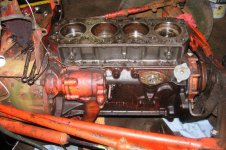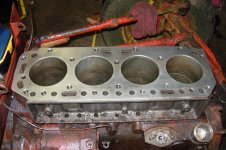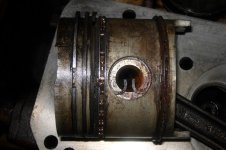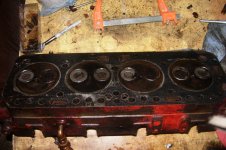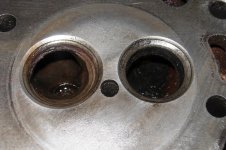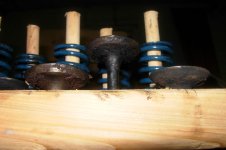Willl
Elite Member
They are definitely aluminum, cause they have to be.To me the pistons look like bright shiny aluminum
They are definitely aluminum, cause they have to be.To me the pistons look like bright shiny aluminum
I think I'm following you around TBN danno1. Good question about the block. I know that these blocks did not have "liners" per se and were directly bored, however there does appear to be two different metals (based on color) that comprise the "block" and the "cylinder" (see pic). My engine was clearly rebored larger by 0.02 (stamped on the pistons; green), but the bores seem to stay within the original cylinder, but rebore was not quite centered (red arrow), likely intentional.
View attachment 108693
If you look at the underneath pic I've highlighted in yellow the piston and block. To me the pistons look like bright shiny aluminum; block looks like steel.
View attachment 108694
I suppose this really doesn't matter for using heat to induce metal expansion, but it's an interesting thought exercise based on several assumptions (never a good mix). Nevertheless, unless I'm mistaken, if you were to heat the pistons directly, being aluminum they would swell up more so than the cylinders and it would be even harder to get them out.
dunno. . danno1
Pete
Based upon engines that I've rebuilt, the darkened area at the top of the cylinder you indicated with red arrows is most likely caused by the head gasket being just slightly larger than the bore and exposing the metal to heat. The "off center" is due to sloppy fit of the gasket on the studs/bolts.
Agreed. I was merely thinking ahead a couple of steps. I honestly have no desire to bore a block myself. In fact, if possible depending upon the condition of the pistons/cyl, I'll most like hone out the cyls, clean 'em up, replace the piston rings, and fire her up. There's some cyl pitting, but I suspect its somewhat cosmetic and she'll run - just burn a little oil. overhaul kits are available for several over sizes, but they're not cheap!TYM,
You can over bore right in to the water jacket. I wouldn't bore past .040 oversize, and I would sugest you take the block to an automotive machine shop to have bored. To remove .020 with a hone can be done, but it will be a chore.
ron
Don't know how much you know about engines, and I'm not trying to treat you like you are in the 1st grade but, don't mix up any rod or main bearing caps as they have to go back EXACTLY as removed. As for hones the "dingleberry" hone leaves a good looking finish but the 3 stone hones will be better in truing a cylinder and removing small imperfections and putting the correct crosshatch in the cylinder. Your head should go to a machine shop for a valve job and resurfacing. I typically use a LARGE (16") mill ******* file to clean the top of the block. Don't use a lot of pressure and do use the fine side. This will tru and resurface the deck without removing too much material. One of the main secrets that my 76 year old (retired mechanic) father always said about building an engine "everything should be clean enough to eat off of". I hope this helps and I'm not trying to be condesending.
